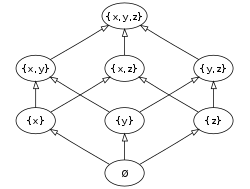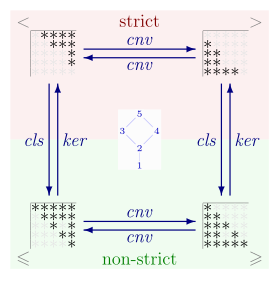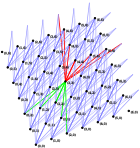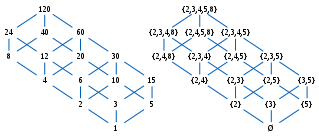Partially ordered set
| Transitivebinary relations | ||||||||||||||||||||||||||||||||||||||||||||||||||||||||||||||||||||||||||||||||||||||||||||||||||||||||||||||||||||||||||||||||||||||||||||||||||||||||||||||||||||||||||||||||||||
|---|---|---|---|---|---|---|---|---|---|---|---|---|---|---|---|---|---|---|---|---|---|---|---|---|---|---|---|---|---|---|---|---|---|---|---|---|---|---|---|---|---|---|---|---|---|---|---|---|---|---|---|---|---|---|---|---|---|---|---|---|---|---|---|---|---|---|---|---|---|---|---|---|---|---|---|---|---|---|---|---|---|---|---|---|---|---|---|---|---|---|---|---|---|---|---|---|---|---|---|---|---|---|---|---|---|---|---|---|---|---|---|---|---|---|---|---|---|---|---|---|---|---|---|---|---|---|---|---|---|---|---|---|---|---|---|---|---|---|---|---|---|---|---|---|---|---|---|---|---|---|---|---|---|---|---|---|---|---|---|---|---|---|---|---|---|---|---|---|---|---|---|---|---|---|---|---|---|---|---|---|
| ||||||||||||||||||||||||||||||||||||||||||||||||||||||||||||||||||||||||||||||||||||||||||||||||||||||||||||||||||||||||||||||||||||||||||||||||||||||||||||||||||||||||||||||||||||
All definitions tacitly require thehomogeneous relationbetransitive:for allifandthen |

Inmathematics,especiallyorder theory,apartial orderon asetis an arrangement such that, for certain pairs of elements, one precedes the other. The wordpartialis used to indicate that not every pair of elements needs to be comparable; that is, there may be pairs for which neither element precedes the other. Partial orders thus generalizetotal orders,in which every pair is comparable.
Formally, a partial order is ahomogeneous binary relationthat isreflexive,antisymmetric,andtransitive.Apartially ordered set(posetfor short) is an ordered pairconsisting of a set(called theground setof) and a partial orderon.When the meaning is clear from context and there is no ambiguity about the partial order, the setitself is sometimes called a poset.
Partial order relations
[edit]The termpartial orderusually refers to the reflexive partial order relations, referred to in this article asnon-strictpartial orders. However some authors use the term for the other common type of partial order relations, the irreflexive partial order relations, also called strict partial orders. Strict and non-strict partial orders can be put into aone-to-one correspondence,so for every strict partial order there is a unique corresponding non-strict partial order, and vice versa.
Partial orders
[edit]Areflexive,weak,[1]ornon-strict partial order,[2]commonly referred to simply as apartial order,is ahomogeneous relation≤ on asetthat isreflexive,antisymmetric,andtransitive.That is, for allit must satisfy:
- Reflexivity:,i.e. every element is related to itself.
- Antisymmetry:ifandthen,i.e. no two distinct elements precede each other.
- Transitivity:ifandthen.
A non-strict partial order is also known as an antisymmetricpreorder.
Strict partial orders
[edit]Anirreflexive,strong,[1]orstrict partial orderis a homogeneous relation < on a setthat istransitive,irreflexive,andasymmetric;that is, it satisfies the following conditions for all
- Transitivity:ifandthen.
- Irreflexivity:,i.e. no element is related to itself (also called anti-reflexive).
- Asymmetry:ifthen not.
A transitive relation is asymmetric if and only if it is irreflexive.[3]So the definition is the same if it omits either irreflexivity or asymmetry (but not both).
A strict partial order is also known as an asymmetricstrict preorder.
Correspondence of strict and non-strict partial order relations
[edit]
Strict and non-strict partial orders on a setare closely related. A non-strict partial ordermay be converted to a strict partial order by removing all relationships of the formthat is, the strict partial order is the setwhereis theidentity relationonanddenotesset subtraction.Conversely, a strict partial order < onmay be converted to a non-strict partial order by adjoining all relationships of that form; that is,is a non-strict partial order. Thus, ifis a non-strict partial order, then the corresponding strict partial order < is theirreflexive kernelgiven by Conversely, if < is a strict partial order, then the corresponding non-strict partial orderis thereflexive closuregiven by:
Dual orders
[edit]Thedual(oropposite)of a partial order relationis defined by lettingbe theconverse relationof,i.e.if and only if.The dual of a non-strict partial order is a non-strict partial order,[4]and the dual of a strict partial order is a strict partial order. The dual of a dual of a relation is the original relation.
Notation
[edit]Given a setand a partial order relation, typically the non-strict partial order,we may uniquely extend our notation to define four partial order relationsand,whereis a non-strict partial order relation on,is the associated strict partial order relation on(theirreflexive kernelof),is the dual of,andis the dual of.Strictly speaking, the termpartially ordered setrefers to a set with all of these relations defined appropriately. But practically, one need only consider a single relation,or,or, in rare instances, the non-strict and strict relations together,.[5]
The termordered setis sometimes used as a shorthand forpartially ordered set,as long as it is clear from the context that no other kind of order is meant. In particular,totally ordered setscan also be referred to as "ordered sets", especially in areas where these structures are more common than posets. Some authors use different symbols thansuch as[6]or[7]to distinguish partial orders from total orders.
When referring to partial orders,should not be taken as thecomplementof.The relationis the converse of the irreflexive kernel of,which is always a subset of the complement of,butis equal to the complement ofif, and only if,is a total order.[a]
Alternative definitions
[edit]Another way of defining a partial order, found incomputer science,is via a notion ofcomparison.Specifically, givenas defined previously, it can be observed that two elementsxandymay stand in any of fourmutually exclusiverelationships to each other: eitherx<y,orx=y,orx>y,orxandyareincomparable.This can be represented by a functionthat returns one of four codes when given two elements.[8][9]This definition is equivalent to apartial order on asetoid,where equality is taken to be a definedequivalence relationrather than set equality.[10]
Wallis defines a more general notion of apartial order relationas anyhomogeneous relationthat istransitiveandantisymmetric.This includes both reflexive and irreflexive partial orders as subtypes.[1]
A finite poset can be visualized through itsHasse diagram.[11]Specifically, taking a strict partial order relation,adirected acyclic graph(DAG) may be constructed by taking each element ofto be a node and each element ofto be an edge. Thetransitive reductionof this DAG[b]is then the Hasse diagram. Similarly this process can be reversed to construct strict partial orders from certain DAGs. In contrast, the graph associated to a non-strict partial order has self-loops at every node and therefore is not a DAG; when a non-strict order is said to be depicted by a Hasse diagram, actually the corresponding strict order is shown.
Examples
[edit]
Standard examples of posets arising in mathematics include:
- Thereal numbers,or in general any totally ordered set, ordered by the standardless-than-or-equalrelation ≤, is a partial order.
- On the real numbers,the usualless thanrelation < is a strict partial order. The same is also true of the usualgreater thanrelation > on.
- By definition, everystrict weak orderis a strict partial order.
- The set ofsubsetsof a given set (itspower set) ordered byinclusion(see Fig. 1). Similarly, the set ofsequencesordered bysubsequence,and the set ofstringsordered bysubstring.
- The set ofnatural numbersequipped with the relation ofdivisibility.(see Fig. 3 and Fig. 6)
- The vertex set of adirected acyclic graphordered byreachability.
- The set ofsubspacesof avector spaceordered by inclusion.
- For a partially ordered setP,thesequence spacecontaining allsequencesof elements fromP,where sequenceaprecedes sequencebif every item inaprecedes the corresponding item inb.Formally,if and only iffor all;that is, acomponentwise order.
- For a setXand a partially ordered setP,thefunction spacecontaining all functions fromXtoP,wheref≤gif and only iff(x) ≤g(x)for all
- Afence,a partially ordered set defined by an alternating sequence of order relationsa<b>c<d...
- The set of events inspecial relativityand, in most cases,[c]general relativity,where for two eventsXandY,X≤Yif and only ifYis in the futurelight coneofX.An eventYcan be causally affected byXonly ifX≤Y.
One familiar example of a partially ordered set is a collection of people ordered bygenealogicaldescendancy. Some pairs of people bear the descendant-ancestor relationship, but other pairs of people are incomparable, with neither being a descendant of the other.
Orders on the Cartesian product of partially ordered sets
[edit]In order of increasing strength, i.e., decreasing sets of pairs, three of the possible partial orders on theCartesian productof two partially ordered sets are (see Fig. 4):
- thelexicographical order:(a,b) ≤ (c,d)ifa<cor (a=candb≤d);
- theproduct order:(a,b) ≤ (c,d) ifa≤candb≤d;
- thereflexive closureof thedirect productof the corresponding strict orders:(a,b) ≤ (c,d)if (a<candb<d) or (a=candb=d).
All three can similarly be defined for the Cartesian product of more than two sets.
Applied toordered vector spacesover the samefield,the result is in each case also an ordered vector space.
See alsoorders on the Cartesian product of totally ordered sets.
Sums of partially ordered sets
[edit]Another way to combine two (disjoint) posets is theordinal sum[12](orlinear sum),[13]Z=X⊕Y,defined on the union of the underlying setsXandYby the ordera≤Zbif and only if:
- a,b∈Xwitha≤Xb,or
- a,b∈Ywitha≤Yb,or
- a∈Xandb∈Y.
If two posets arewell-ordered,then so is their ordinal sum.[14]
Series-parallel partial ordersare formed from the ordinal sum operation (in this context called series composition) and another operation called parallel composition. Parallel composition is thedisjoint unionof two partially ordered sets, with no order relation between elements of one set and elements of the other set.
Derived notions
[edit]The examples use the posetconsisting of theset of all subsetsof a three-element setordered by set inclusion (see Fig. 1).
- aisrelated tobwhena≤b.This does not imply thatbis also related toa,because the relation need not besymmetric.For example,is related tobut not the reverse.
- aandbarecomparableifa≤borb≤a.Otherwise they areincomparable.For example,andare comparable, whileandare not.
- Atotal orderorlinear orderis a partial order under which every pair of elements is comparable, i.e.trichotomyholds. For example, the natural numbers with their standard order.
- Achainis a subset of a poset that is a totally ordered set. For example,is a chain.
- Anantichainis a subset of a poset in which no two distinct elements are comparable. For example, the set ofsingletons
- An elementais said to bestrictly less thanan elementb,ifa≤bandFor example,is strictly less than
- An elementais said to becoveredby another elementb,writtena⋖b(ora<:b), ifais strictly less thanband no third elementcfits between them; formally: if botha≤bandare true, anda≤c≤bis false for eachcwithUsing the strict order <, the relationa⋖bcan be equivalently rephrased as "a<bbut nota<c<bfor anyc".For example,is covered bybut is not covered by
Extrema
[edit]
There are several notions of "greatest" and "least" element in a posetnotably:
- Greatest elementand least element: An elementis agreatest elementiffor every elementAn elementis aleast elementiffor every elementA poset can only have one greatest or least element. In our running example, the setis the greatest element, andis the least.
- Maximal elementsand minimal elements: An elementis a maximal element if there is no elementsuch thatSimilarly, an elementis a minimal element if there is no elementsuch thatIf a poset has a greatest element, it must be the unique maximal element, but otherwise there can be more than one maximal element, and similarly for least elements and minimal elements. In our running example,andare the maximal and minimal elements. Removing these, there are 3 maximal elements and 3 minimal elements (see Fig. 5).
- Upper and lower bounds:For a subsetAofP,an elementxinPis an upper bound ofAifa≤x,for each elementainA.In particular,xneed not be inAto be an upper bound ofA.Similarly, an elementxinPis a lower bound ofAifa≥x,for each elementainA.A greatest element ofPis an upper bound ofPitself, and a least element is a lower bound ofP.In our example, the setis anupper boundfor the collection of elements

As another example, consider the positiveintegers,ordered by divisibility: 1 is a least element, as itdividesall other elements; on the other hand this poset does not have a greatest element. This partially ordered set does not even have any maximal elements, since anygdivides for instance 2g,which is distinct from it, sogis not maximal. If the number 1 is excluded, while keeping divisibility as ordering on the elements greater than 1, then the resulting poset does not have a least element, but anyprime numberis a minimal element for it. In this poset, 60 is an upper bound (though not a least upper bound) of the subsetwhich does not have any lower bound (since 1 is not in the poset); on the other hand 2 is a lower bound of the subset of powers of 2, which does not have any upper bound. If the number 0 is included, this will be the greatest element, since this is a multiple of every integer (see Fig. 6).
Mappings between partially ordered sets
[edit]Given two partially ordered sets(S,≤)and(T,≼),a functionis calledorder-preserving,ormonotone,orisotone,if for allimpliesf(x) ≼f(y). If(U,≲)is also a partially ordered set, and bothandare order-preserving, theircompositionis order-preserving, too. A functionis calledorder-reflectingif for allf(x) ≼f(y)implies Iffis both order-preserving and order-reflecting, then it is called anorder-embeddingof(S,≤)into(T,≼). In the latter case,fis necessarilyinjective,sinceimpliesand in turnaccording to the antisymmetry ofIf an order-embedding between two posetsSandTexists, one says thatScan beembeddedintoT.If an order-embeddingisbijective,it is called anorder isomorphism,and the partial orders(S,≤)and(T,≼)are said to beisomorphic.Isomorphic orders have structurally similarHasse diagrams(see Fig. 7a). It can be shown that if order-preserving mapsandexist such thatandyields theidentity functiononSandT,respectively, thenSandTare order-isomorphic.[15]
For example, a mappingfrom the set of natural numbers (ordered by divisibility) to thepower setof natural numbers (ordered by set inclusion) can be defined by taking each number to the set of itsprime divisors.It is order-preserving: ifxdividesy,then each prime divisor ofxis also a prime divisor ofy.However, it is neither injective (since it maps both 12 and 6 to) nor order-reflecting (since 12 does not divide 6). Taking instead each number to the set of itsprime powerdivisors defines a mapthat is order-preserving, order-reflecting, and hence an order-embedding. It is not an order-isomorphism (since it, for instance, does not map any number to the set), but it can be made one byrestricting its codomaintoFig. 7b shows a subset ofand its isomorphic image underg.The construction of such an order-isomorphism into a power set can be generalized to a wide class of partial orders, calleddistributive lattices;seeBirkhoff's representation theorem.
Number of partial orders
[edit]SequenceA001035inOEISgives the number of partial orders on a set ofnlabeled elements:
| Elements | Any | Transitive | Reflexive | Symmetric | Preorder | Partial order | Total preorder | Total order | Equivalence relation |
|---|---|---|---|---|---|---|---|---|---|
| 0 | 1 | 1 | 1 | 1 | 1 | 1 | 1 | 1 | 1 |
| 1 | 2 | 2 | 1 | 2 | 1 | 1 | 1 | 1 | 1 |
| 2 | 16 | 13 | 4 | 8 | 4 | 3 | 3 | 2 | 2 |
| 3 | 512 | 171 | 64 | 64 | 29 | 19 | 13 | 6 | 5 |
| 4 | 65,536 | 3,994 | 4,096 | 1,024 | 355 | 219 | 75 | 24 | 15 |
| n | 2n2 | 2n(n−1) | 2n(n+1)/2 | ∑n k=0k!S(n,k) |
n! | ∑n k=0S(n,k) | |||
| OEIS | A002416 | A006905 | A053763 | A006125 | A000798 | A001035 | A000670 | A000142 | A000110 |
Note thatS(n,k)refers toStirling numbers of the second kind.
The number of strict partial orders is the same as that of partial orders.
If the count is made onlyup toisomorphism, the sequence 1, 1, 2, 5, 16, 63, 318,... (sequenceA000112in theOEIS) is obtained.
Subposets
[edit]A posetis called asubposetof another posetprovided thatis asubsetofandis a subset of.The latter condition is equivalent to the requirement that for anyandin(and thus also in), ifthen.
Ifis a subposet ofand furthermore, for allandin,wheneverwe also have,then we callthe subposet ofinducedby,and write.
Linear extension
[edit]A partial orderon a setis called anextensionof another partial orderonprovided that for all elementswheneverit is also the case thatAlinear extensionis an extension that is also a linear (that is, total) order. As a classic example, the lexicographic order of totally ordered sets is a linear extension of their product order. Every partial order can be extended to a total order (order-extension principle).[16]
Incomputer science,algorithms for finding linear extensions of partial orders (represented as thereachabilityorders ofdirected acyclic graphs) are calledtopological sorting.
In category theory
[edit]Every poset (and everypreordered set) may be considered as acategorywhere, for objectsandthere is at most onemorphismfromtoMore explicitly, lethom(x,y) = {(x,y)}ifx≤y(and otherwise theempty set) andSuch categories are sometimes calledposetal.
Posets areequivalentto one another if and only if they areisomorphic.In a poset, the smallest element, if it exists, is aninitial object,and the largest element, if it exists, is aterminal object.Also, every preordered set is equivalent to a poset. Finally, every subcategory of a poset isisomorphism-closed.
Partial orders in topological spaces
[edit]Ifis a partially ordered set that has also been given the structure of atopological space,then it is customary to assume thatis aclosedsubset of the topologicalproduct spaceUnder this assumption partial order relations are well behaved atlimitsin the sense that ifandand for allthen[17]
Intervals
[edit]Aconvex setin a posetPis a subsetIofPwith the property that, for anyxandyinIand anyzinP,ifx≤z≤y,thenzis also inI.This definition generalizes the definition ofintervalsofreal numbers.When there is possible confusion withconvex setsofgeometry,one usesorder-convexinstead of "convex".
Aconvex sublatticeof alatticeLis a sublattice ofLthat is also a convex set ofL.Every nonempty convex sublattice can be uniquely represented as the intersection of afilterand anidealofL.
Anintervalin a posetPis a subset that can be defined with interval notation:
- Fora≤b,theclosed interval[a,b]is the set of elementsxsatisfyinga≤x≤b(that is,a≤xandx≤b). It contains at least the elementsaandb.
- Using the corresponding strict relation "<", theopen interval(a,b)is the set of elementsxsatisfyinga<x<b(i.e.a<xandx<b). An open interval may be empty even ifa<b.For example, the open interval(0, 1)on the integers is empty since there is no integerxsuch that0 <x< 1.
- Thehalf-open intervals[a,b)and(a,b]are defined similarly.
Whenevera≤bdoes not hold, all these intervals are empty. Every interval is a convex set, but the converse does not hold; for example, in the poset of divisors of 120, ordered by divisibility (see Fig. 7b), the set {1, 2, 4, 5, 8} is convex, but not an interval.
An intervalIis bounded if there exist elementssuch thatI⊆[a,b].Every interval that can be represented in interval notation is obviously bounded, but the converse is not true. For example, letP=(0, 1)∪(1, 2)∪(2, 3)as a subposet of the real numbers. The subset(1, 2)is a bounded interval, but it has noinfimumorsupremuminP,so it cannot be written in interval notation using elements ofP.
A poset is calledlocally finiteif every bounded interval is finite. For example, the integers are locally finite under their natural ordering. The lexicographical order on the cartesian productis not locally finite, since(1, 2) ≤ (1, 3) ≤ (1, 4) ≤ (1, 5) ≤... ≤ (2, 1). Using the interval notation, the property "ais covered byb"can be rephrased equivalently as
This concept of an interval in a partial order should not be confused with the particular class of partial orders known as theinterval orders.
See also
[edit]- Antimatroid,a formalization of orderings on a set that allows more general families of orderings than posets
- Causal set,a poset-based approach to quantum gravity
- Comparability graph– Graph linking pairs of comparable elements in a partial order
- Complete partial order– Mathematical phrase
- Directed set– Mathematical ordering with upper bounds
- Graded poset– partially ordered set equipped with a rank function
- Incidence algebra– Associative algebra used in combinatorics, a branch of mathematics
- Lattice– Set whose pairs have minima and maxima
- Locally finite poset– Mathematics
- Möbius function on posets– Associative algebra used in combinatorics, a branch of mathematics
- Nested set collection
- Order polytope
- Ordered field– Algebraic object with an ordered structure
- Ordered group– Group with a compatible partial order
- Ordered vector space– Vector space with a partial order
- Poset topology,a kind of topological space that can be defined from any poset
- Scott continuity– continuity of a function between two partial orders.
- Semilattice– Partial order with joins
- Semiorder– Numerical ordering with a margin of error
- Szpilrajn extension theorem– every partial order is contained in some total order.
- Stochastic dominance– Partial order between random variables
- Strict weak ordering– strict partial order "<" in which the relation"neithera<bnorb<a"is transitive.
- Total order– Order whose elements are all comparable
- Zorn's lemma– Mathematical proposition equivalent to the axiom of choice
Notes
[edit]- ^A proof can be foundhere.
- ^which always exists and is unique, sinceis assumed to be finite
- ^SeeGeneral relativity § Time travel.
Citations
[edit]- ^abcWallis, W. D. (14 March 2013).A Beginner's Guide to Discrete Mathematics.Springer Science & Business Media. p. 100.ISBN978-1-4757-3826-1.
- ^Simovici, Dan A. & Djeraba, Chabane (2008)."Partially Ordered Sets".Mathematical Tools for Data Mining: Set Theory, Partial Orders, Combinatorics.Springer.ISBN9781848002012.
- ^Flaška, V.; Ježek, J.; Kepka, T.; Kortelainen, J. (2007)."Transitive Closures of Binary Relations I".Acta Universitatis Carolinae. Mathematica et Physica.48(1). Prague: School of Mathematics – Physics Charles University: 55–69.Lemma 1.1 (iv). This source refers to asymmetric relations as "strictly antisymmetric".
- ^Davey & Priestley (2002),pp.14–15.
- ^Avigad, Jeremy; Lewis, Robert Y.; van Doorn, Floris (29 March 2021). "13.2. More on Orderings".Logic and Proof(Release 3.18.4 ed.).Retrieved24 July2021.
So we can think of every partial order as really being a pair, consisting of a weak partial order and an associated strict one.
- ^Rounds, William C. (7 March 2002)."Lectures slides"(PDF).EECS 203: DISCRETE MATHEMATICS.Retrieved23 July2021.
- ^Kwong, Harris (25 April 2018). "7.4: Partial and Total Ordering".A Spiral Workbook for Discrete Mathematics.Retrieved23 July2021.
- ^"Finite posets".Sage 9.2.beta2 Reference Manual: Combinatorics.Retrieved5 January2022.
compare_elements(x,y): Comparexandyin the poset. Ifx<y,return −1. Ifx=y,return 0. Ifx>y,return 1. Ifxandyare not comparable, return None.
- ^Chen, Peter; Ding, Guoli; Seiden, Steve.On Poset Merging(PDF)(Technical report). p. 2.Retrieved5 January2022.
A comparison between two elements s, t in S returns one of three distinct values, namely s≤t, s>t or s|t.
- ^Prevosto, Virgile; Jaume, Mathieu (11 September 2003).Making proofs in a hierarchy of mathematical structures.CALCULEMUS-2003 – 11th Symposium on the Integration of Symbolic Computation and Mechanized Reasoning. Roma, Italy: Aracne. pp. 89–100.
- ^Merrifield, Richard E.;Simmons, Howard E.(1989).Topological Methods in Chemistry.New York: John Wiley & Sons. pp.28.ISBN0-471-83817-9.Retrieved27 July2012.
A partially ordered set is conveniently represented by aHasse diagram...
- ^ Neggers, J.; Kim, Hee Sik (1998), "4.2 Product Order and Lexicographic Order",Basic Posets,World Scientific, pp. 62–63,ISBN9789810235895
- ^Davey & Priestley (2002),pp.17–18.
- ^P. R. Halmos (1974).Naive Set Theory.Springer. p.82.ISBN978-1-4757-1645-0.
- ^Davey & Priestley (2002),pp. 23–24.
- ^Jech, Thomas(2008) [1973].The Axiom of Choice.Dover Publications.ISBN978-0-486-46624-8.
- ^Ward, L. E. Jr (1954)."Partially Ordered Topological Spaces".Proceedings of the American Mathematical Society.5(1): 144–161.doi:10.1090/S0002-9939-1954-0063016-5.hdl:10338.dmlcz/101379.
References
[edit]- Davey, B. A.; Priestley, H. A. (2002).Introduction to Lattices and Order(2nd ed.). New York: Cambridge University Press.ISBN978-0-521-78451-1.
- Deshpande, Jayant V. (1968)."On Continuity of a Partial Order".Proceedings of the American Mathematical Society.19(2): 383–386.doi:10.1090/S0002-9939-1968-0236071-7.
- Schmidt, Gunther(2010).Relational Mathematics.Encyclopedia of Mathematics and its Applications. Vol. 132. Cambridge University Press.ISBN978-0-521-76268-7.
- Bernd Schröder (11 May 2016).Ordered Sets: An Introduction with Connections from Combinatorics to Topology.Birkhäuser.ISBN978-3-319-29788-0.
- Stanley, Richard P.(1997).Enumerative Combinatorics 1.Cambridge Studies in Advanced Mathematics. Vol. 49. Cambridge University Press.ISBN0-521-66351-2.
- Eilenberg, S.(2016).Foundations of Algebraic Topology.Princeton University Press.
- Kalmbach, G. (1976). "Extension of Homology Theory to Partially Ordered Sets".J. Reine Angew. Math.280:134–156.
External links
[edit]![]() Media related toHasse diagramsat Wikimedia Commons; each of which shows an example for a partial order
Media related toHasse diagramsat Wikimedia Commons; each of which shows an example for a partial order




























































































































![{\displaystyle P^{*}=P[X^{*}]}](https://wikimedia.org/api/rest_v1/media/math/render/svg/b4739d74d3a23e9ce9c7645030240cd78b43ab7d)














![{\displaystyle [a,b]=\{a,b\}.}](https://wikimedia.org/api/rest_v1/media/math/render/svg/c22504982538e7e532e76ad1ebfafd8abd6bb8f2)